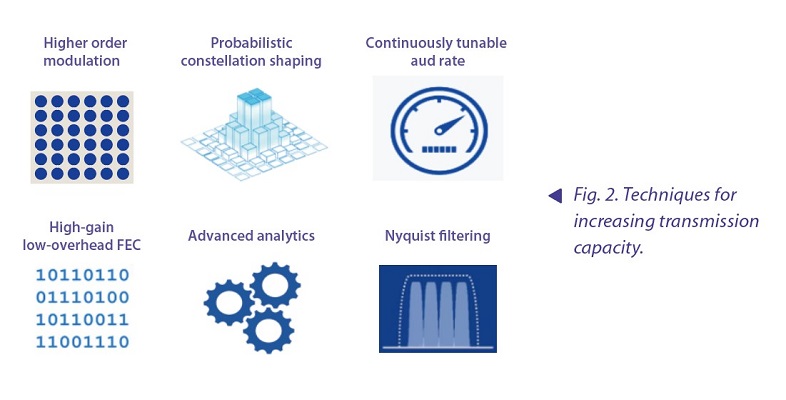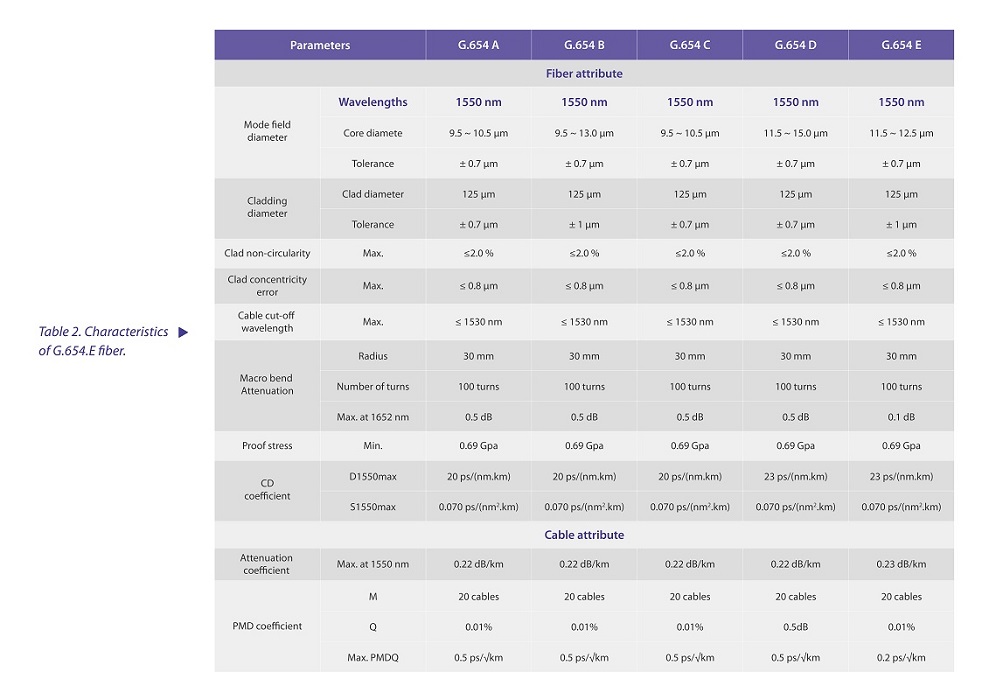Application of G.654.E Fiber for High-Capacity Long-Distance Transmission Systems
Introduction
As we enter the 5G era with applications like ultra reliable low latency communications (URLLC), massive machine type communications (mMTC), and especially enhanced mobile broadband (eMBB), we face extremely high requirements for transmission capacity—over 10 times that of 4G technology.
To handle this explosion in data traffic, dense wavelength division multiplexing (DWDM) optical transmission technologies have emerged, significantly increasing the transmission capacity per fiber—up to 8 times over the last 10 years (Fig. 1).

While DWDM transmission equipment has continued to develop rapidly, the optical fiber medium used for transmission hasn’t seen much change. For the last 20 years, the most commonly used fibers have been G.652D and G.655 (Leaf) fibers.
With on-off keying (OOK) technology, the transmission quality in DWDM systems is heavily influenced by fiber characteristics, such as polarization mode dispersion (PMD) and chromatic dispersion (CD). To reduce the impact of CD, operators have switched to using G.655 fiber, which has a lower CD coefficient (≤ 6 ps/(nm.km)), instead of G.652 fiber, which has a higher coefficient (up to 18 ps/(nm.km)). This switch helps improve transmission quality but raises costs by about 7.5% per kilometer for 24 fiber optic cables (comprising 18 G.652 fibers and 6 G.655 fibers) compared to cables that use only G.652 fibers.
The introduction of coherent technology, used in DWDM systems with transmission capacities per wavelength of ≥100G, has completely eliminated the impact of CD on transmission quality. As a result, G.655 fiber is no longer needed. However, as transmission capacities increase, the system also requires better optical signal-to-noise ratios (OSNR) on the fiber. To accommodate these higher capacities, devices need more advanced chipsets that can handle higher modulation formats (up to 64QAM or 256QAM), higher baud rates (up to 96 Gbaud or more), and other advanced techniques like probabilistic constellation shaping (PCS) or Nyquist filtering (Fig. 2). On the physical side, reducing noise from fiber loss and nonlinear effects is essential.

By early 2022, many DWDM equipment manufacturers had released devices supporting transmission rates of up to 800G per wavelength over distances longer than 900 km. However, there remains a significant gap between the new technology and existing cable networks. At that time, Viettel, the largest telecom operator in Vietnam, tested high-capacity transmission of 800G per wavelength and found that the transmission distance was limited due to nonlinear effects and fiber loss, as shown in Table 1.
High-capacity transmission distances are primarily limited by high fiber attenuation (average 0.3 dB/km). To improve transmission distances with high capacities, we need to address the physical factors affecting the transmission medium.
To meet these needs, ITU-T introduced the G.654 standard for optical fibers. G.654 fibers have various subclasses A/B/C/D/E to serve different purposes.
History of G.654 Fiber
G.654 fiber is a single-mode fiber with a pure silica core, designed to minimize loss at a wavelength of 1550 nm. It was developed in the mid-1980s for long-distance submarine optical fiber systems, as it offers about 10% less loss than G.652 fiber at this wavelength. In DWDM systems, optical fibers show nonlinear characteristics when transmitting high-capacity, long-distance signals. This reduces system performance when the input power exceeds a certain threshold due to the fiber’s nonlinear effects.
The power density in the fiber core affects nonlinear effects. When the input power is constant, nonlinear effects can be reduced by increasing the fiber’s effective area, thereby lowering the core’s power density. As a result, G.654 fiber began to be mentioned in technical documents regarding improvements in the “effective area”. Increasing the effective area also raises the cut-off wavelength, which needs to be carefully managed to ensure the fiber performs well in the C-band (1530–1565 nm). G.654 fibers have a cut-off wavelength of 1530 nm, but in 2000, the ITU revised this and introduced the term “cut-off wavelength shifted single-mode fiber”. Low attenuation and a large effective area are the two main characteristics of G.654 fibers today.
Characteristics of G.654.E Fiber
In terrestrial transmission systems, G.652.D is the most commonly used optical fiber. The nonlinear effects of the fiber increasingly impact transmission performance as the transmission speed on a single wavelength of the DWDM system reaches 100G. At this point, G.654 fiber has drawn the attention of researchers and been adopted in long-distance backbone transmission systems. The macro bending loss criteria of G.654 fiber used on land are generally stricter than those used in underwater applications (macro bending loss in accordance with G.652D standards). In addition to having low attenuation, the effective area is also larger compared to the fiber used underwater. Due to this requirement, G.654E has become the industry standard. The differences in key transmission parameters for each subclass of G.654 fiber are shown in Table 2.

Advantages of G.654.E Fiber
OSNR is a critical factor in the performance of optical networks. G.654.E fiber has very low macro-bending loss and a large effective area, which improves OSNR by reducing transmission loss and allowing for higher launch power. A 1 dB improvement in OSNR can increase transmission distance by 25%, a 2 dB improvement by 60%, and a 3 dB improvement by up to 100%. Fig. 3 compares the performance of G.654.E fiber with other types.

G.654E fiber has two different effective areas: 110 μm² (A110) and 130 μm² (A130). The A110 and A130 fibers were used in China’s backbone networks from 2015 to 2018. After 2018, only the A130 fiber was used for building backbone networks. The G.654E (A130) fiber has an effective area that is 47% larger than the G.652D (A80) fiber. With unchanged nonlinear effects, the optimal optical input power can be increased by about 1.7 dB. G.654E fiber has a typical attenuation coefficient that is approximately 0.02 dB/km lower than that of G.652D fiber. The optical loss of G.654E fiber is about 1.6 dB lower than that of G.652D fiber over an 80 km fiber span.
Because the locations of optical amplifier stations in the terrestrial backbone transmission system was fixed, increasing the optical input power and reducing fiber loss will not significantly decrease the number of optical amplification stations required. However, the OSNR value of G.654.E fiber can be improved by approximately 3 dB compared to G.652 fiber, assuming that the optical amplification/repeater stations remain unchanged.
In addition to low attenuation and a large effective area, G.654.E fiber also operates over a wide temperature range, from -65°C to 85°C, making it suitable for deployment in terrestrial transmission systems.
Disadvantages of G.654.E Fiber
Despite its advantages, G.654.E fiber has some notable drawbacks. For instance, its cut-off wavelength is limited to 1530 nm (Fig. 4), making it unsuitable for short-distance transmission (such as metro access networks). Moreover, G.654.E fiber is more expensive, costing 1.5 to 2 times more than G.652.D fiber, which limits its market share.

Real-World Applications of G.654.E Fiber
Recently, fiber and cable manufacturers have developed G.654.E fiber for use in terrestrial optical transmission systems. By 2017, two major telecom operators in China had commercially deployed G.654.E fiber for 400G DWDM transmission systems: China Unicom ( about 472 km) and China Telecom (1,500 km). By the end of 2021, Chinese telecom operators had implemented G.654.E fiber in projects totaling approximately 41,000 km of cable, focusing on upgrading the East-West backbone links to support high-capacity DWDM systems.
- In 2021, China Telecom completed a backbone fiber link from Shanghai to Guangzhou, spanning 1,970 km.
- In 2022, China Telecom announced the 2022 backbone cable project, with the first phase covering 3,621 km, equivalent to about 610,000 km of fiber cores using G.654.E cable.
- In 2022, China Mobile initiated centralized procurement of G.654.E cable, totaling 2,134 km, equivalent to 332,400 km of fiber cores.
- In 2023, China Mobile’s centralized procurement of G.654.E cable increased nearly fourfold, covering 8,463 km, equivalent to 1.2279 million km of fiber cores.
At the beginning of 2023, Viettel, in collaboration with ZTE, tested a 1 Tb/s DWDM system using G.654.E and G.652.D fibers. The results showed that the 1 Tbps wavelength was transmitted over a distance of 1,040 km using G.654.E fiber, which is 1.5 times the distance achievable with G.652.D fiber.